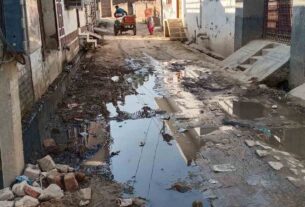A group of artists are reviving the idea of organic paints using soil colours.
By Yashasvini Razdan
With majority of art forms devoted to oil and acrylic bases, , the city is witnessing the advent of a unique organic art form called ‘soil painting’.
A group of artists are promoting this unique art form by painting a large mural at the Cubbon Park Metro station using soil colours. The paint used to design the mural is derived from the mud extracted during the digging of 65 recharge wells. These wells are being facilitated within the park–by Biome Environmental Solutions, which is a group of ecological design experts.
Anna, a member of the group, Art in Transit, told The Softcopy that the mural is painted using mud and clay.
“The mud that is used to create the paint has been sourced from various recharge wells. Since the mud has been sourced from different sites, it has varying shades ranging from red to yellow, due to the geographical variations. The paint is created by mixing lime and iron oxide with the mud using a special process. This paint is organic and completely biodegradable, unlike the regular acrylic and oil paints,” she said.
A research paper titled, “Case studies of soil in art” by Gerd Wessolek and Alexandra Toland states that soil has been used as a medium for pigmentingthe prehistoric wall paintings in caves and in contemporary paintings, in order to give special effects to the subject.
Ms. Sumitra, the curator of Karnataka Chitrakala Museum said that soil or mineral colours are completely organic.
She said, “These colours can easily disintegrate with paper. They are eco- friendly and non-toxic. Minerals have been used for a long time to derive natural colours. Inorganic paints only came after the late 1800s after the invention of paper.”
Ritunsha, an artist, explained the usage and composition of acrylic and oil colours in murals.
She said, “The use of acrylic and oil colours in designing murals is very widespread. Acrylic colours dry very quickly and can be used with water as a medium. Oil paints take a lot of time to dry and the medium used is usually turpentine.”
She added that solvents which contain petroleum are harmful as the contents evaporate and release fumes.
Ms. Sajda Niket, a biochemistry professor in Government Science College, Bangalore explained the chemical composition of acrylic paints. She said, “Acrylic paints contain synthetic acrylic resins and pigments with many additives. These additives contain an ammonia-based stabilizer and formaldehyde preservatives. When the paint is drying, small amounts of these chemicals are released which can cause respiratory irritation and allergies. Formaldehyde can also cause cancer in animals.”
Anna said that this mural would help raise more awareness about many problems faced by the city.
“By using an unusual media like soil, we hope to make to tell visual stories about well digging as well as highlight the significance of organic media like soil for painting.”




